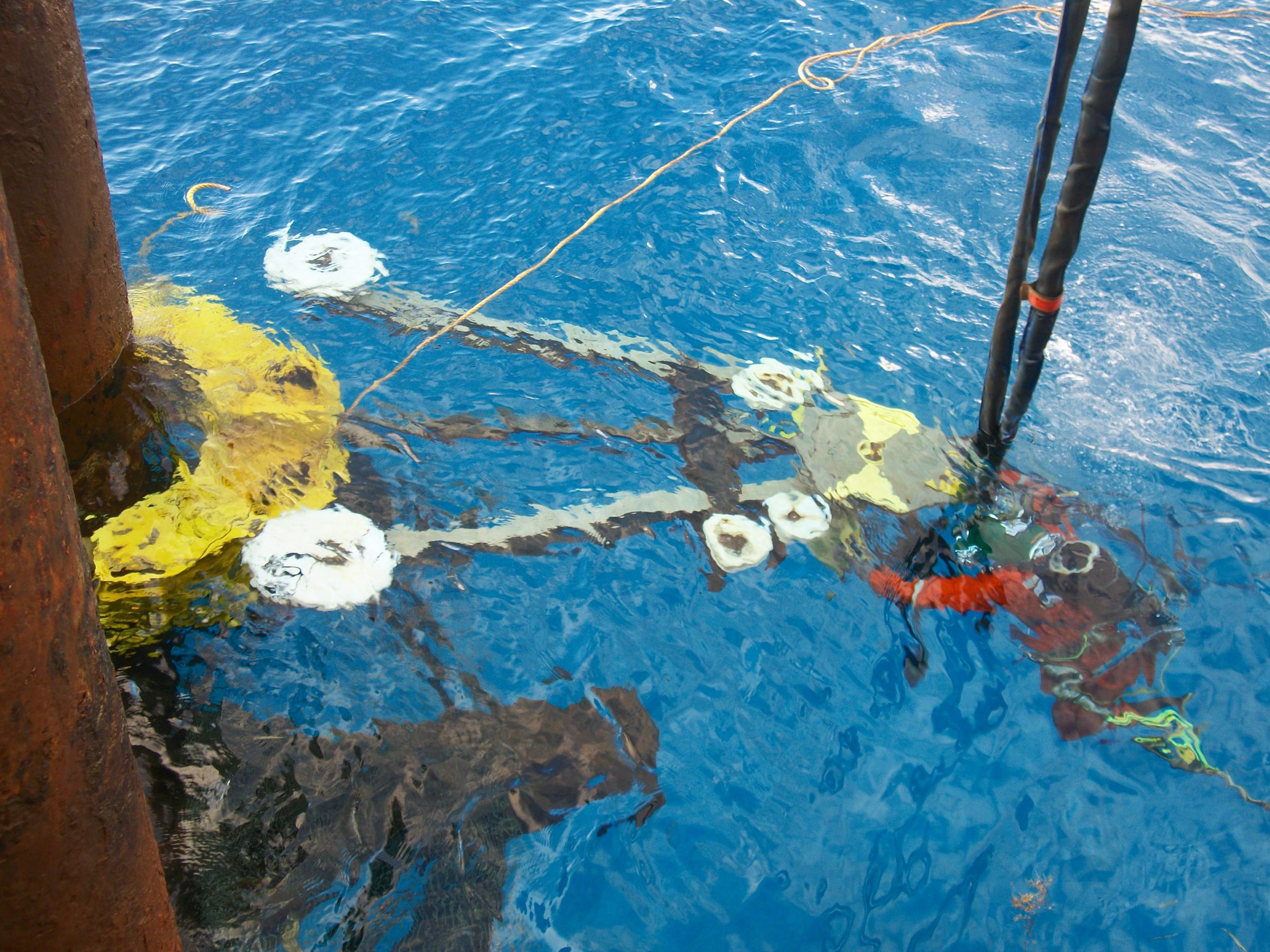
A Cut Above (from Below)

Underwater Wire Sawing Techniques Have Proven Success
The innovative technique of wire sawing originated in quarries to extract stone and was quickly applied to cut thick concrete. Today, contractors use diamond wire to cut and remove large sections of heavily-reinforced concrete on piers, dams, bridge sections and in areas where work space is restricted. Of these restricted work areas, none present more challenges than when the structure is underwater.
One CSDA member has specialized in the completion of large wire sawing projects since its inception almost 20 years ago and has been involved with a number of complex underwater jobs. Cutting Edge Services Corporation of Batavia, Ohio has assisted with critical cleanup operations beneath the water’s surface in seas, rivers and dams.
Katrina Cleanup
Hurricane Katrina reigns as the costliest natural disaster in the history of the United States and one of the five deadliest on record. Over 1,200 people died and total property damage exceeded $108 billion. Today, 11 years on since the disaster, the cleanup continues not just on land but on “unseen” subsea structures and pipelines in the Gulf of Mexico. Winds from Hurricane Katrina exceeding 175 mph damaged over 50 oil-producing platforms, sinking two and pushing one 68 miles. The hurricane also destroyed over 100 miles of pipeline carrying crude oil to U.S. shores.
In November of 2005, Integra Technologies, a manufacturer of radar and avionics equipment approached Cutting Edge Services Corp., a CSDA member since 1997, in search of diamond wire machines and technicians to cut pipes and structures in the Gulf of Mexico. No North American underwater wire saws were available at this time, so the contractor immediately got to work developing a concept that would provide undersea saws and technicians. Black Machining, also of Batavia, was contacted by Cutting Edge to fabricate a special clamp to support the primary elements of a WS-25 hydraulic wire saw from Diamond Products. The initial request was to cut undersea “conductor pipes”—triple wall steel pipes, with the outer pipe measuring 20 inches in diameter and the inner pipe carrying crude oil.
The first 20-inch subsea saw was completed in early January 2006 and shipped to Houston, Texas for testing. Tiburon Divers and W&T Offshore placed the saw in a dive tank and conducted a series of operational tests, which the saw successfully passed.

A pair of dolphin pilings were cut in the Bahamas using a 36-inch wire saw.
At the actual jobsite, technicians covered round the clock shifts and worked off ships or barges. Saws were pre-run on deck, then handed over to the dive team. The wire saw technician had radio contact with the dive team to provide instruction for the correct clamping of the saw. Once sawing was underway, only significantly bad weather cleared the deck and stopped operations.
The work involved long hours and a fair share of frustrations for the contractor, but the cutting always got done. Cut sections were either placed on deck or temporarily left on sea floor for removal by others.
Thanks to the marketing efforts of Integra, word spread quickly, and by the end of 2006 six saws were in operation, including larger 24- and 36-inch models. Cutting Edge and Integra then formed a partnership called BTC Subsea for all work in the Gulf of Mexico, a partnership that remains in effect today.
Out of Sight, Not Out of Control
With the rare exception of using underwater cameras, wire saw operators control underwater cutting from a deck, platform or ship. The hydraulic power unit and control station stay dry, while the saw is set in place with diver assistance up to 200 feet deep. The use of a diver is minimal, as the saw clamps into position within minutes and the loop of diamond wire continually moves through the pipe or structure. The divers do not have to pull wires and make connections. The operator maintains a set pressure range on the wire, as they have no visual or noise contact with the saw or cutting face. Pending the completion of the cut, and the attachment of the cut section to a crane, progress can be stopped and wedges inserted to prevent the wire from being pinched in the cut.
When Borco’s operation in Freeport, Bahamas needed to upgrade its offshore refueling platform, the company contacted Cal Dive who in turn reached out to Integra/Cutting Edge for diamond wire cutting solutions. A self-clamping saw was deployed to cut a pair of 36-inch diameter dolphin pilings. Each dolphin was 12-foot wide by 24-feet high. After setup, each cut took approximately one hour to complete.

“Big Red,” a 96-inch saw, surfaces after underwater cutting an 8-foot-diameter pier.
The contractor was then notified of a need to wire saw 8-foot-diameter triple-wall piers. The outer wall was 3 inches thick, with 6-foot and 4-foot pipes grouted within. This prompted fabrication of “Big Red,” a double-mast, self-clamping saw that could handle cuts 96 inches across. There were eight Borco piers that required six cuts each. In total, Cutting Edge made 48 cuts averaging seven hours per cut and 5 feet in diameter.
In Search of Cooler Waters
In 2012, general contractor American Marine of Anchorage, Alaska contacted Cutting Edge regarding a need to cut 24-inch steel pilings for BP on Northstar Island, off Prudhoe Bay. The customer would maintain a hole in the ice while divers would set the saw in place for cutting operations. Several 24-inch pilings with 1-inch steel walls were cut. The average cut time was just 45 minutes and the contractor completed over 200 cuts between 2006 and 2008.
A year later, American Marine put Cutting Edge to work on the wire sawing contractor’s smallest saw yet, made for creating 6- to 9-inch-diameter cuts and weighing only 86 pounds. Shell Oil had a manifold stuck at a new well site in the Chukchi Sea, between Alaska and Russia. Cutting Edge was contracted to build and test cut four small saws, to be used as a back-up in case the primary band saw failed—it did. The wire saws were called to action and four critical wire saw cuts were made. Steve Stuart, dive master for American Marine, was quick to praise these efforts. “The Cutting Edge wire saws saved the day!” he said.
The Return of Big Red

Wire saw push or pull cuts can cut and remove large parts of a structure, like this 8-foot diameter steel reinforced concrete pier.
More recently, in 2015, Walsh Construction approached Cutting Edge about performing several underwater cuts for two new bridges over the Ohio River in Louisville, Kentucky. This was an easy answer for the contractor, as Big Red was ready and waiting. These mammoth 8-foot-diameter piers were required to support construction of the new bridges. The outer steel shell was 1-inch thick and a circle of #18 steel bars were embedded in the concrete fill. The wire saw operator used Big Red to cut five piers making up to four cuts on each, averaging eight hours per cut. In some instances, the saw would be flipped upside down to cut nearly flush to the river bottom and achieve the correct elevation for the customer. In total, 14 pier sections were cut and lifted out, averaging 55 tons per pick.
These are just a few examples of how underwater wire sawing with diamond tools can be a cut above (or below) other methods. Wire sawing provides increased speed and precision with reduced vibration and noise compared with other demolition techniques. It places the operator a safe distance from the cutting face, reducing safety risks, while maintaining the structural integrity of whatever is being cut—critical when working on and around damaged underwater structures.
Company Profile
Cutting Edge Services Corporation has been in business for 18 years and is based in Batavia, Ohio. Support operations are located in Houston and Richland, Washington. The company offers primary services of engineered solutions, diamond wire sawing, underwater cutting and core drilling. Cutting Edge has been a member of CSDA since 1997, employs CSDA Certified Operators and is certified through the association’s Company Certification Program.
Resources
Sawing and Drilling Contractors:
Cutting Edge Services Corporation
Batavia, Ohio
Phone: 513-388-0199
Email: beckman@cuttingedgeservices.com
Website: www.cuttingedgeservices.com















Trackbacks/Pingbacks